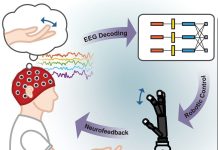
In a new study, researchers found that noise is not the same as noise—and even a quiet environment does not have the same effect as white noise.
With a background of continuous white noise, hearing pure sounds becomes even more precise.
Their findings could be applied to the further development of cochlear implants.
The research was conducted by a team from the University of Basel.
Despite the importance of hearing in human communication, we still understand very little of how acoustic signals are perceived and how they are processed to allow us to make sense of them.
One thing is clear though: the more precisely we can distinguish sound patterns, the better our hearing is.
But how does the brain manage to distinguish between relevant and less relevant information—especially in an environment with background noise?
In the study, the team examined the neuronal foundation of sound perception and sound discrimination in a challenging sound environment.
The focus was on research into the auditory cortex—the “auditory brain,” that is, the area of the brain that processes acoustic stimuli. The resulting activity patterns stem from measurements in a mouse brain.
As is well known, the distinction between sounds becomes more difficult the closer they are in the frequency spectrum.
Initially, the researchers assumed that additional noise could make such a hearing task even more difficult.
However, the opposite was observed: The team was able to demonstrate that the brain’s ability to distinguish subtle tone differences improved when white noise was added to the background.
Compared to a quiet environment, the noise thus facilitated auditory perception.
The data showed that white noise strongly inhibited the activity of the nerve cells in the auditory cortex.
Paradoxically, this suppression of the neuronal excitation led to a more precise perception of the pure tones.
To confirm that the auditory cortex and not another area of the brain was responsible for the change in sound perception, the researchers used the light-controlled technique optogenetic.
Their findings could possibly be used to improve auditory perception in situations where sounds are difficult to distinguish.
One author of the study is Prof. Dr. Tania Rinaldi Barkat from the Department of Biomedicine.
The study is published in Cell Reports.
Copyright © 2019 Knowridge Science Report. All rights reserved.



